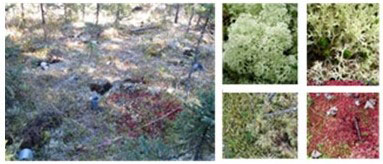Home > International Partnerships > Collaborative Research > Effects of Bryophytes and Lichens on Nutrient Cycling in Circumpolar Forest Ecosystems
Update:March 22, 2021
Main content starts here.
Effects of Bryophytes and Lichens on Nutrient Cycling in Circumpolar Forest Ecosystems

1. Partners
International Arctic Research Center (IARC), University of Alaska Fairbanks, United States of America
2. Research Period
FY 2015-2019 Grant-in-Aid for Scientific Research (KAKENHI)
3. Lead Researcher
MORISHITA, Tomoaki (Tohoku Research Center)
4. Background
Forest ecosystems in the circumpolar region vary greatly and could be affected by climate change which, in turn, would affect global nutrient cycling. The thick organic layer plays an important role in nutrient cycling in these ecosystems, while secondary metabolites derived from plants and organisms also have some effect. However, the nature of this effect differs among regions due to differences in the climate, species, and soil.
5. Research Goal
The aim of this research was to evaluate the effects of bryophytes and lichens on nutrient cycling in the circumpolar region by examining:
1) Differences in the bryophyte and lichen communities on the forest floor in various circumpolar regions.
2) The annual production of these bryophytes and lichens.
3) The production of biogenic volatile organic compounds (BVOC) by these bryophytes and lichens.
6. Research Strategy
We measured the community composition and production of bryophytes and lichens and the BVOC concentrations in the soil in Scots pine (Pinus sylvestris) stands in Northern Europe, larch (Larix spp.) stands in Siberia, black spruce (Picea mariana) stands in Alaska, and jack pine (Pinus banksiana) stands in Canada.

Photographs of the forest floor in the circumpolar region and the species of bryophytes and lichens that occur there
7. Scientific Achievement
In the forest ecosystems of the various circumpolar regions, the species of bryophytes and lichens are similar among regions; however, their coverage ratio and production rate differ among the regions. At a black spruce forest in Alaska, in which the coverage ratio and production rate differ along the slope, greenhouse gas dynamics and monoterpene concentrations in the soil differ among the positions of the slope. Some bryophytes produce types of monoterpenes that may affect the carbon and nitrogen dynamics in the ecosystems rather than temperature and water content.
8. Applications
The findings of this study will promote an understanding of carbon and nitrogen dynamics in boreal forest ecosystems.
9. Publications
Tomoaki Morishita, Takafumi Miyam, Kenji Ono, Yongwon Kim, Akira Osawa, Kyotaro Noguchi, Yojiro Matsuura. Seasonal and spatial changes of BVOC concentration in forest soils, BIOGEOMON2017 Abstracts, Litmysl, 74, 2017.
Tomoaki Morishita, Kyotaro Noguchi, Yojiro Matsuura, Yongwon Kim. Greenhouse gas fluxes from forest soil in an upland black spruce stand in interior Alaska, World Congress of Soil Science, Rio de Janeiro, 2018.
Tomoaki Morishita, Takafumi Miyama, Kyotaro Noguchi, Yojiro Matsuura, Yongwon Kim. Spatiotemporal Variations of Below-Ground Monoterpene Concentrations in an Upland Black Spruce Stand in Interior Alaska, Polar Science, 21, 158-164, 2019.
Copyright © Forest Research and Management Organization. All rights reserved.
